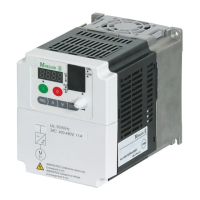Installation
09/01 AWB8230-1412GB
24
Fit additional RFI filters or mains filters and frequency inverters as
closely as possible to each other and on a single metal plate
(mounting plate).
Lay cables in the control cabinet as near as possible to the ground
potential. Cables that hang freely act as antennae.
To prevent transfer of electromagnetic energy, lay interference-
suppressed cables (e.g. mains supply before the filter) and signal
lines as far away as possible (at least 10 cm) from HF-conducting
cables (e.g. mains supply cable after a filter, motor power cable).
This applies especially where cables are routed in parallel. Never
use the same cable duct for interference-suppressed and HF
cables. Where unavoidable, cables should always cross over at
right angles to each other.
Never lay control or signal cables in the same duct as power
cables. Analog signal cables (measured values, setpoints and
correction values) must be screened.
Grounding
Connect the ground plate (mounting plate) with the protective
earth using a short cable. To achieve the best results, all conduc-
ting components (frequency inverter, mains filter, motor filter,
mains choke) should be connected by an HF wire, and the protec-
tive conductor should be laid in a star configuration from a central
earthing point. This produces the best results.
Ensure that the earthing measures have been correctly imple-
mented (a Fig. 14). No other device which has to be earthed
should be connected to the earthing terminal of the frequency
inverter. If more than one frequency inverter is to be used, the eart-
hing cables should not form a closed loop.
Screening
Unscreened cables behave like antennae, i.e. they act as transmit-
ters and receivers. To ensure EMC-compliant connection, screen
all interference-emitting cables (frequency inverter/motor output)
and interference-sensitive cables (analog setpoint and measured
value cables).
The effectiveness of the cable screen depends on a good screen
connection and a low screen impedance. Use only screens with
tinned or nickel plated copper braiding, braided steel screens are
unsuitable. The screen braid must have an overlap ratio of at least
85 percent and an overlap angle of 90°.
Figure 14: Star-type point to point earthing
e
PE
Z1G1 Gn Zn
PE
PE
M1
PE PE
M
3h
Mn
M
3h
Figure 15: Sample motor cable
a CU screen braid
b PVC outer sheath
c Strands (CU-strands)
d PVC core insulation
3 x black, 1 x green/yellow
e Textile braid and PVC inner material
b
a
e
d
c

